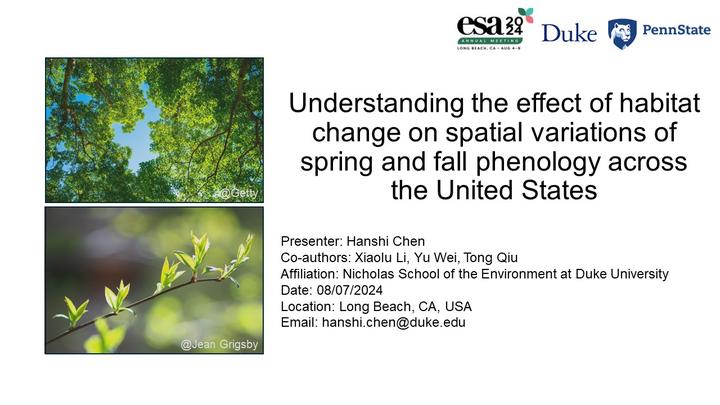
Hanshi’s abstract: Vegetation phenology is the intra-annual variations of vegetation growth and can modulate the energy and gas exchanges between the atmosphere and biosphere. Temporal trends of vegetation phenology and their response to climate change have been extensively studied. Lacking behind is its spatial patterns, which could be influenced by habitat. For example, canopy gaps, introduced by disturbance, dieback, and harvest, could modulate the microclimate conditions and thus indirectly affect vegetation phenology across the forest landscape. However, such effects remain poorly understood, mainly due to the large investment associated with data collection on habitat and phenology. To what extent could canopy gaps modulate temperature effects on vegetation phenology? How will these effects differ across biomes? To answer these questions, we synthesized multi-source remote sensing within a Bayesian hierarchical framework. Specifically, we quantified the interactive effects of canopy gaps and climate on spring green-up and fall senescence at 25 sites across the National Ecological Observatory Network (NEON). We derived canopy gaps and the timing of vegetation phenology from Light Detection And Ranging (LiDAR) and PlanetScope imagery at a continental scale, respectively. We find that canopy gaps lead to earlier spring green-up in 60% of sites, predominantly in the Northeast and in the Midwest. By contrast, canopy gaps were associated with a delayed spring green-up in all sites located within Temperate Rain Forest (TRF) and Tropical Seasonal Forest/savanna (TrSF/S). Canopy gaps also delay fall senescence in 72% of sites, especially in the Northeastern, Southeastern, and Western regions. All sites within TRF and TrSF/S, as well as 82% of sites within Temperate Seasonal Forest (TmSF), show the same delayed response to the presence of canopy gaps. Furthermore, canopy gaps also play a key role in mediating temperature impacts on vegetation phenology. Approximately 76% of sites show that the interactions mitigate impacts of temperature on spring green-up. As for fall senescence, the interactions from 48% and 40% of sites mitigate and amplify temperature impacts, respectively. Our results suggested that habitat should be incorporated in future phenological modeling. Because habitat is under the direct control of conservation managers, results of this study have direct implications in better managing forests in the context of global change.